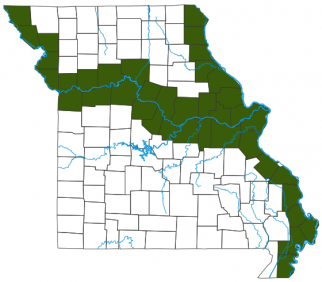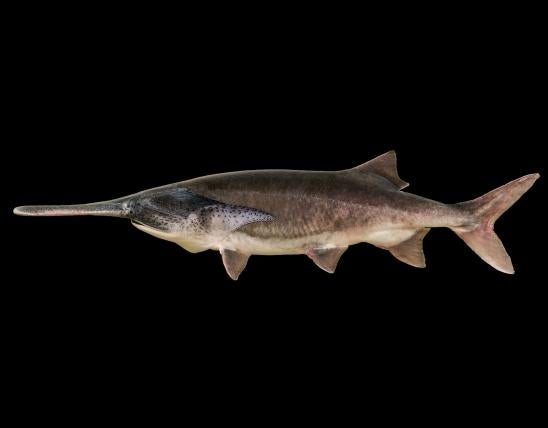
The lake sturgeon has a long, streamlined, sharklike body; long bony snout; and rows of sharp, bony, armored plates (scutes). The sucker-type mouth is located under the long bony snout. Lake sturgeon have short, rounded, conical snouts compared to the shovel-nosed look of our other sturgeon species. Also, the four barbels dangling from in front of the mouth on a lake sturgeon are smooth and not fringed or serrated. Young lake sturgeon are mottled light and dark brown. Adults are solid dark brown or slate-colored with white belly.
Length: to 8 feet; weight: to 300 pounds.

The lake sturgeon occurs mainly in the Mississippi and Missouri rivers, but it has also been known to occur in the two rivers’ larger tributaries.
Habitat and Conservation
Despite its name, in Missouri this fish is almost always found in big rivers, not lakes. It prefers firm, silt-free bottoms of sand, gravel, and rock. The decline of this endangered species is being fought with several approaches: Protection from fishing, reestablishing self-sustaining populations, habitat improvement and river management to provide more of the areas these fish need to survive, artificial propagation, research and population monitoring, management, and education.
Food
Sturgeon feed on the bottom using their highly protrusible mouth to suck up their food. They eat primarily larval aquatic insects, crayfish, snails, small clams, and small fish. As they grow larger, their dependency on small fish for food increases. However, sturgeon can be scavengers at times, feeding on dead animal matter, and are often caught by catfish anglers using worms or cut bait (cut-up fish).
Status
Rare and endangered in Missouri.
Life Cycle
Lake sturgeon can live to be 150 years old and become mature at 15–20 years of age. They don’t spawn every year. Females only spawn once every 3–5 years. This slow reproductive rate makes sturgeon vulnerable to overharvest. They are extremely migratory fish, and they can travel hundreds of miles each year on spawning migrations. Spawning peaks in the first half of May. Human alterations of river channels have ruined much of the habitat sturgeon need to breed and for their young to survive.
Human Connections
Sturgeon have a history of overharvest for various uses, but especially for their flesh and caviar.
Lake sturgeon are now protected and must be returned to the water if captured.
Sturgeon evolved during the Jurassic era and survived where the dinosaurs didn’t. Sturgeon are living links to the past.
Ecosystem Connections
These fish have thrived for 150 million years and have been brought to the brink of extinction in just the last century. They are eight-foot-long, bottom-feeding predator-scavengers specially fitted for life in the swift currents of our big rivers; their role cannot be duplicated by other fish.































